
Mastering API Development: A Comprehensive Guide
You must be familiar with the word “API” if you are a computer enthusiast or work in the digital world. We utilize APIs frequently in our daily lives, from purchasing tickets to logging into Facebook to paying with PayPal.
You can better comprehend the need and intent for API development with the aid of this comprehensive tutorial!
An API (Application Programming Interface) is a protocol or set of rules that allows various web and mobile applications to communicate and interact with each other. It defines how requests and responses should be structured, enabling developers to access specific features or data from one application to use in another and facilitating integration and automation.
Many of you might be confusing APIs with web services.
A web service is a piece of software that is accessible and allows for data transfers when used with a web address. Every web service is an API because it makes an application’s data and functionality available to other apps. However, not all APIs are web services.
An architectural design known as microfrontend separates an application into smaller, independent parts (also known as microservices). REST APIs are used to connect these parts. Look at the API industry market size that has increased over the years.
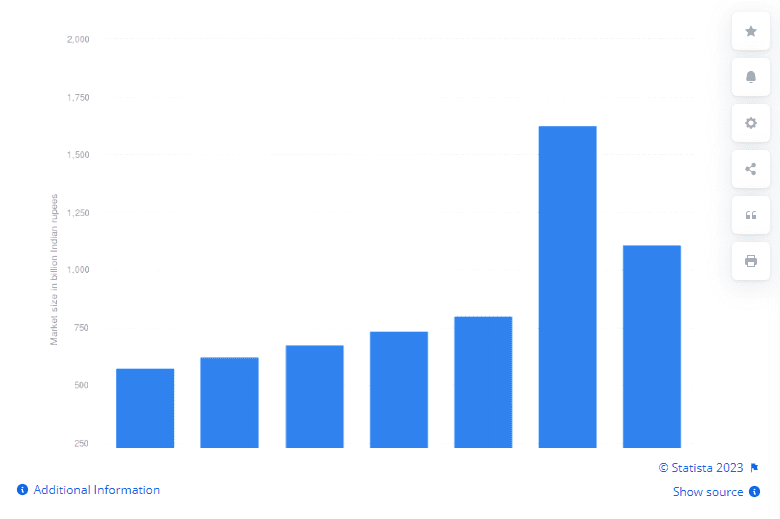
API development is necessary to enable communication across various software applications, services, or platforms. They make it easier for developers to expand on already-existing systems, develop new services, and improve user experiences. This promotes integration, innovation, and scalability.
This comprehensive guide will cover the principles of API design in detail, along with the best practices and tools accessible. The concepts, categories, and protocols involved are some topics we will cover here.
We’ll begin by describing the role APIs play in modern software development and how they make it possible for diverse program components to communicate with each other effortlessly.
What is API?
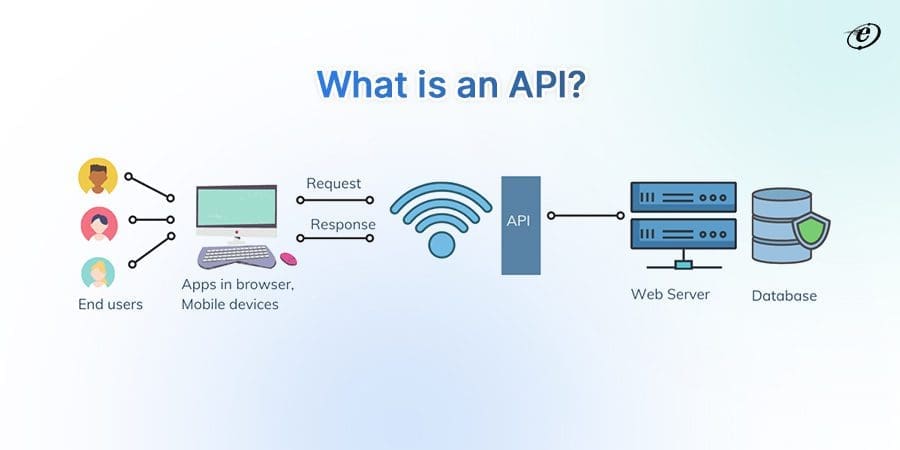
Have you ever questioned how two applications communicate with one another?
APIs, or application programming interfaces, is the answer.
API is a type of software interface that enables communication between two applications. An API is, in other words, a messenger that transports your request to the provider you are seeking and then delivers a response.
Let’s understand with an example.
Top software companies, like Google, Facebook, and others, use APIs to build their apps and then make these programs available to different web developers. For instance, programmers can utilize the Google API to design specific maps for their products. The two elements of an application programming interface are:
-
-
- Technical specifications that outline the data interchange possibilities between products are completed through data delivery methods and requests for processing.
- It is represented by a software interface that is written to the specification.
-
Hence, we can say that an API is nothing but a set of requirements and instructions that allow an application or piece of software to use functions or features from another program, gadget, or platform to provide superior services.

Technically speaking, it’s a group of computer programs that permit data transfer between two software programs. When you hire dedicated developers, they will also consider the terms of this data exchange.
Similarly, Application Programming Interface development (API), is the process of creating and maintaining the interfaces that allow several software programs to communicate with one another. API development involves defining a set of rules, protocols, and endpoints that enable data and functionality to be shared and utilized by front end development companies and other software systems.
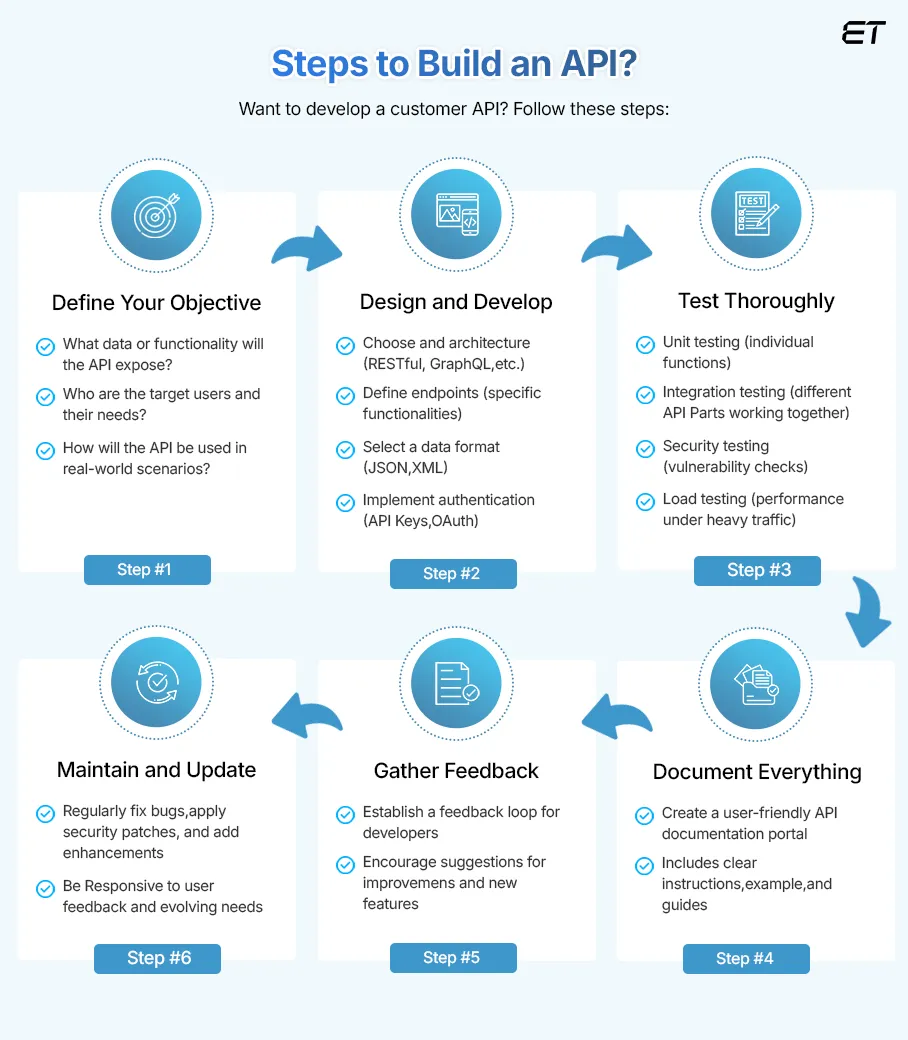
-
Common API Terminology
API (Application Programming Interface) development comes with its own set of terminology and jargon.
Here are some standard API terms:
- Endpoint: A specific URL or URI representing a resource or functionality provided by the API.
- Request: A client’s call to an API’s endpoint, typically using HTTP methods like GET, POST, PUT, or DELETE.
- Response: The data or result returned by the API after processing a request, typically in JSON or XML format.
- HTTP: HyperText Transfer Protocol, the foundation of data communication on the web and often used for API communication.
- REST (Representational State Transfer): An architectural style for designing networked applications, often used for web APIs.
- HTTP Status Code: A three-digit code sent by the server to indicate the result of a request (e.g., 200 for success, 404 for not found).
- Rate Limiting: Restricting the number of requests, a client can make an API within a defined time period to prevent abuse.
- Versioning: The practice of maintaining and supporting different API versions to ensure backward compatibility as it evolves.
- Webhooks: Callbacks or HTTP requests made by the API to notify clients of specific events or updates.
- SSL/TLS (Secure Sockets Layer/Transport Layer Security): Protocols that provide secure and encrypted communication between the client and the API.
- SOAP (Simple Object Access Protocol): A protocol for exchanging structured information to implement web services.
- RESTful: An API design that adheres to REST principles, emphasizing statelessness and resource-based architecture.
- Proxy: An intermediary server that forwards client requests to another server or API.
Some Common Examples of APIs:
| Type | Example | Description |
| Web API | Google Maps API | Provides access to Google Maps services for embedding maps, geolocation, and route planning in applications. |
| Operating System API | Windows API | Provides a set of functions and procedures for developing Windows applications, allowing control over various system resources and services. |
| Database API | MySQL API | Allows applications to interact with the MySQL relational database management system. |
| Hardware API | Webcam API | Allows access to a computer’s webcam for capturing images and video. |
| Social Media API | Instagram API | Provides access to Instagram’s data and features, allowing dedicated developers to display user photos and interact with the platform. |
| Cloud Service API | Amazon Web Services (AWS) API | Offers a wide range of APIs for cloud services like EC2 (Elastic Compute Cloud), S3 (Simple Storage Service), and more. |
How Does API Operates?
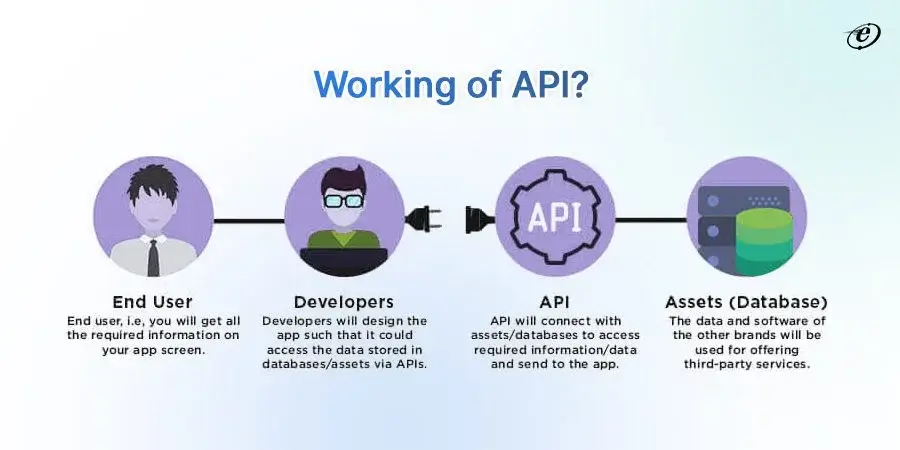
APIs are integral to modern software development, enabling custom web application developers to leverage the functionality of other systems, share data securely, and create a wide range of applications and services that work seamlessly together.
Let’s take an example to understand the workings of APIs!
A weather application (client) must display the current weather conditions for a specific location. The weather application is a client that requested the weather API, which provided the requested weather data in response.
The API served as an intermediary that retrieved and processed the information from a weather service or database, ultimately enabling the application to display up-to-date weather conditions to its users.
| Steps | Explanation |
| Request | The weather application requests a weather API for the current weather information. The request typically includes:
|
| API Processing | The weather API receives the request. It may validate the request, ensuring that the location and requested data are in the correct format and that the API key (if required for authentication) is valid. |
| Action | The API, with access to a weather database or a real-time weather service, acts. It retrieves the current weather data for the specified location, which might include information like temperature (in degrees Celsius or Fahrenheit), humidity (as a percentage), and weather conditions (e.g., “partly cloudy”). |
| Response | The API sends a response back to the weather application. The response is typically in a structured data format containing the requested weather information, such as JSON or XML. |
| Integration | The weather application processes the JSON response from the API and displays the current weather conditions to the user. It might render a user-friendly interface with the information, such as showing “New York, NY: 20°C, 55% humidity, partly cloudy.” |
What are the Types of API?
There are various types of APIs, each designed for specific use cases and communication protocols. Each kind of API serves a different purpose and follows specific communication standards, making them suitable for various development scenarios. Leading development companies choose the API that best fits their project’s requirements and integration needs.
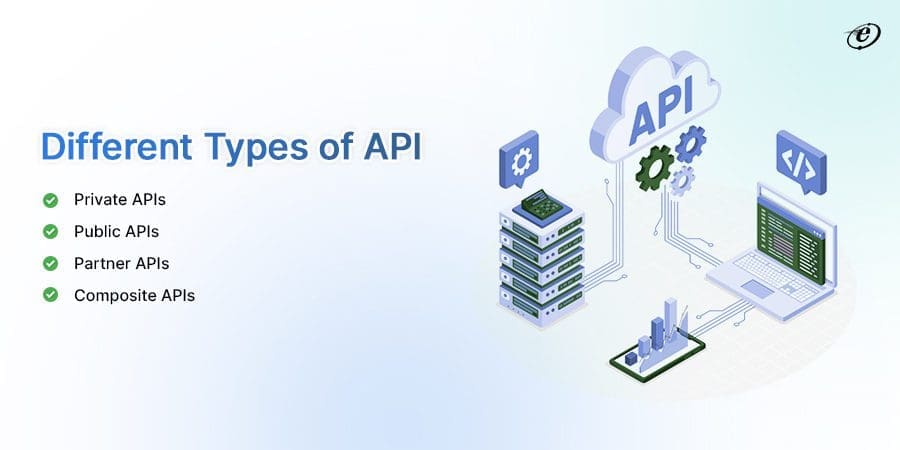
-
Private APIs
Private APIs, also known as internal or open APIs, are made to enhance services and solutions offered by the company. Both internal developers and outsourcing companies can utilize these APIs to build new systems.
Private APIs have lax authentication and authorization requirements because they do not require security. The security standards of all business systems are sufficient to manage these APIs, which are solely used internally.
These are only applicable within an organization. These are the best for tying together business processes and data. API connections between payroll and other HR systems inside an organization are some of the greatest examples.
-
Public APIs
Public APIs are sometimes known as external APIs or developer-facing APIs. These APIs are public, so any developer or frontend development team can utilize them. Because of this, many businesses that want to provide APIs for development just offer public APIs that are widely available.
These APIs employ intermediate levels of permission and authentication. Businesses can profit from both the per-call fees and the monetization of their open APIs.
Public APIs are divided into two groups
- Open APIs
- Commercial APIs
According to the Open API, all of its features are available to everyone and are not subject to any usage restrictions. Customers have the option of paying membership fees or paying when they use commercial APIs. Moreover, publications offer free trials so customers can test out APIs before subscribing.
-
Partner APIs
As the name implies, these APIs are solely intended for use in business-to-business transactions. Partner APIs are used in software integration between two parties. They are also freely promoted and given to the business associates that have a contract with the publisher. A company might create new revenue streams by providing its partners benefits regarding capabilities and data access.
In the interim, they can also keep an eye on how exposed digital assets are being used. Moreover, they also examine the user experience offered by the external applications that use their APIs. They also ensure that the corporate identity of their apps is maintained.
Partner APIs have advanced authentication, security, and authorization levels compared to all other APIs.
-
Composite APIs
Different service and data APIs are frequently combined through composite APIs. These are developed by combining pre-existing API methods to do several tasks in a single call. This improves the listeners’ performance in the web interfaces while speeding up execution.
Multiple data or service APIs are combined into composite APIs. They enable custom web application developers to communicate with several endpoints simultaneously. Composite APIs are helpful in a microservices design, where a single job may require information from numerous sources.

What are the Best API Development Tools?
The API development tools play a crucial role in simplifying the process of designing, building, testing, and maintaining APIs. The choice of tool depends on the specific requirements of the API project and the developer’s preferences. It’s essential to stay updated with the latest tools and technologies in the API landscape as it evolves.
Here are some of the top development tools
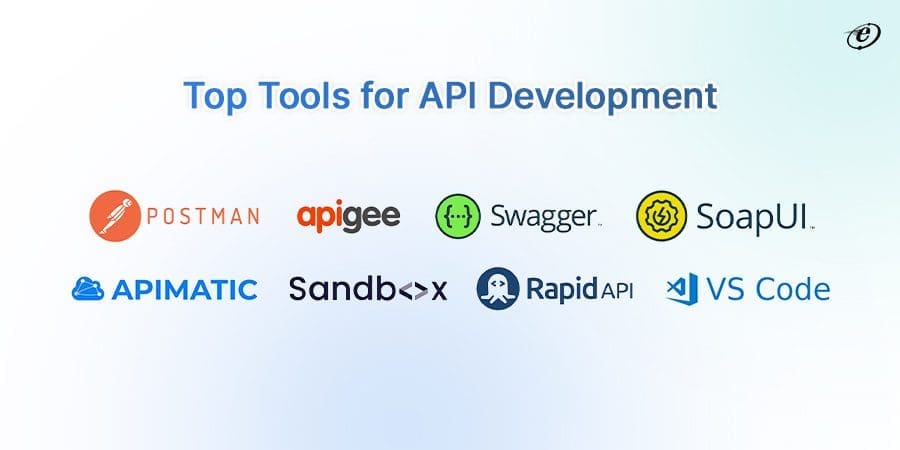
-
-
-
Postman
-
-
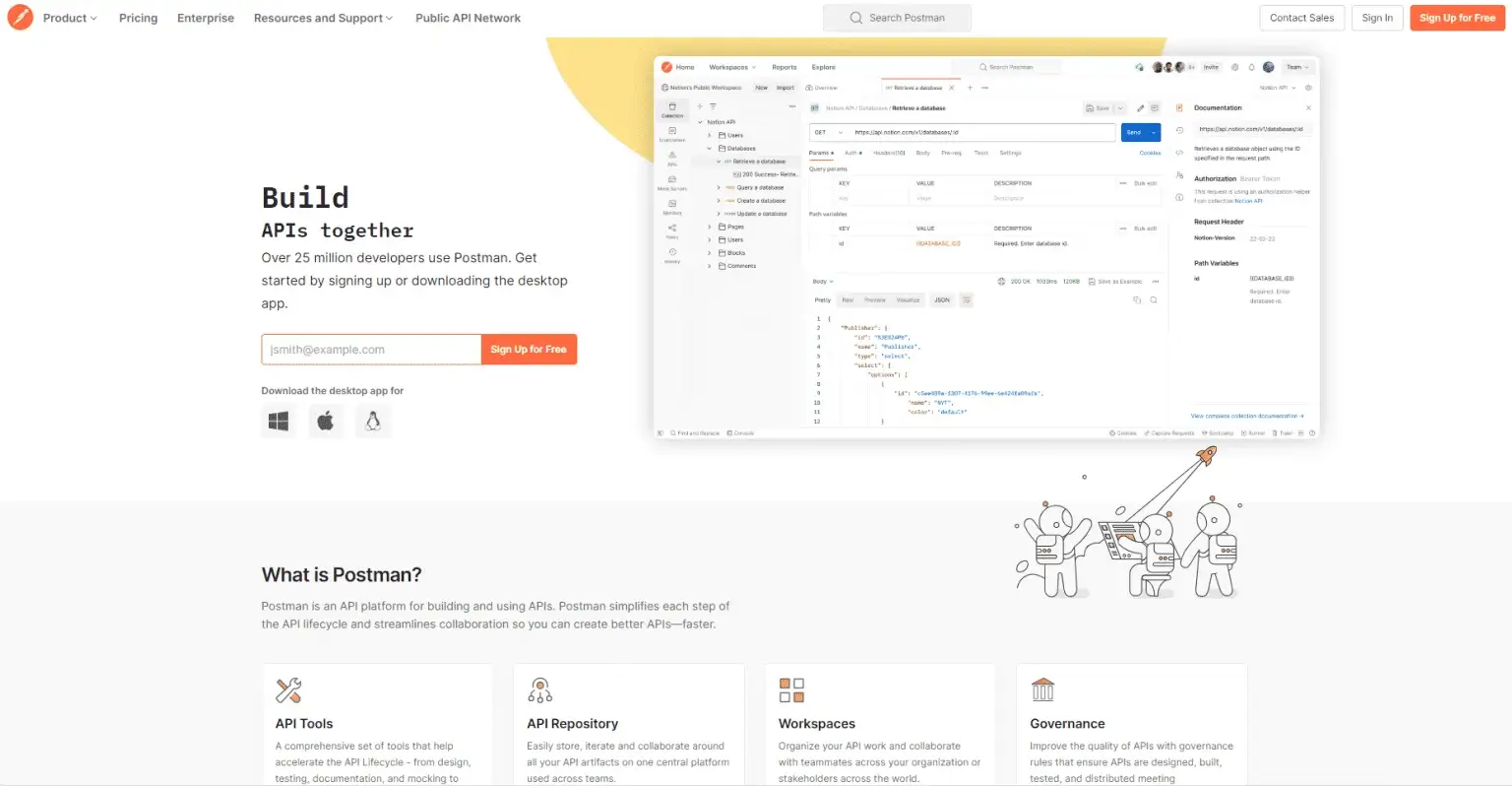
Postman is a popular and user-friendly API development tool that assists in designing, testing, and documenting APIs. It supports the creation of requests, automated testing, and the generation of API documentation.
-
Apigee

Google’s Apigee is a management tool for developing API. Many developers and business owners utilize Apigee to steer the digital revolution. This option is helpful when a company wants to update its outdated apps or make data transfer across apps and services easier. In addition, it helps frontend and backend developers when they create connected apps.
Connecting with professionals who use the best API integration tools. Send your requirements and find the best associate.
-
Swagger
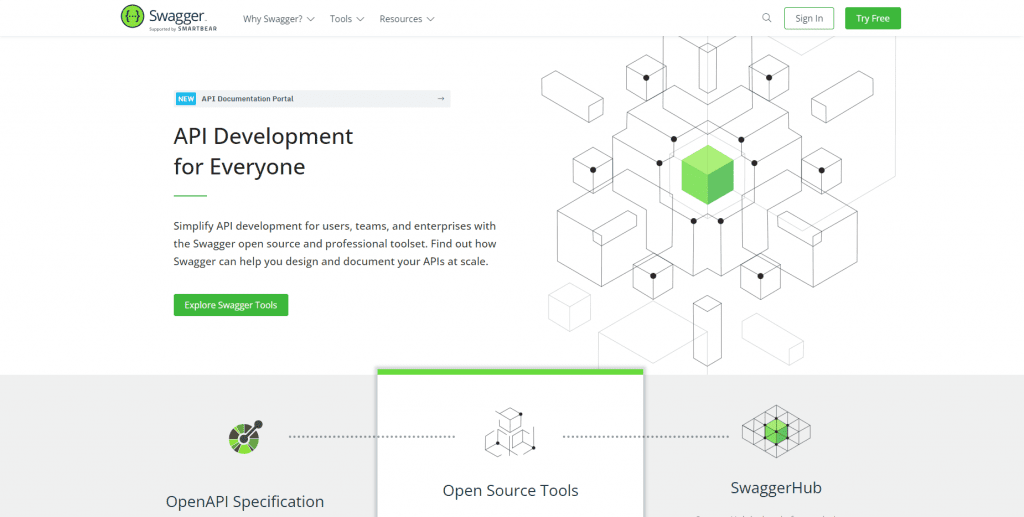
Swagger, now known as the OpenAPI Specification, provides a framework for designing, building and documenting RESTful APIs. It offers a clear and standardized way to define API endpoints and their behavior.
-
SoapUI

SoapUI is an open-source, cross-platform-compatible testing tool. It may also automate functional and non-functional tests. It is utilized for Web API regression, compliance, execution, security, and load testing. While initially designed for testing SOAP web services, SoapUI has also evolved to support RESTful APIs. It provides powerful testing capabilities and automation features.
-
APIMatic
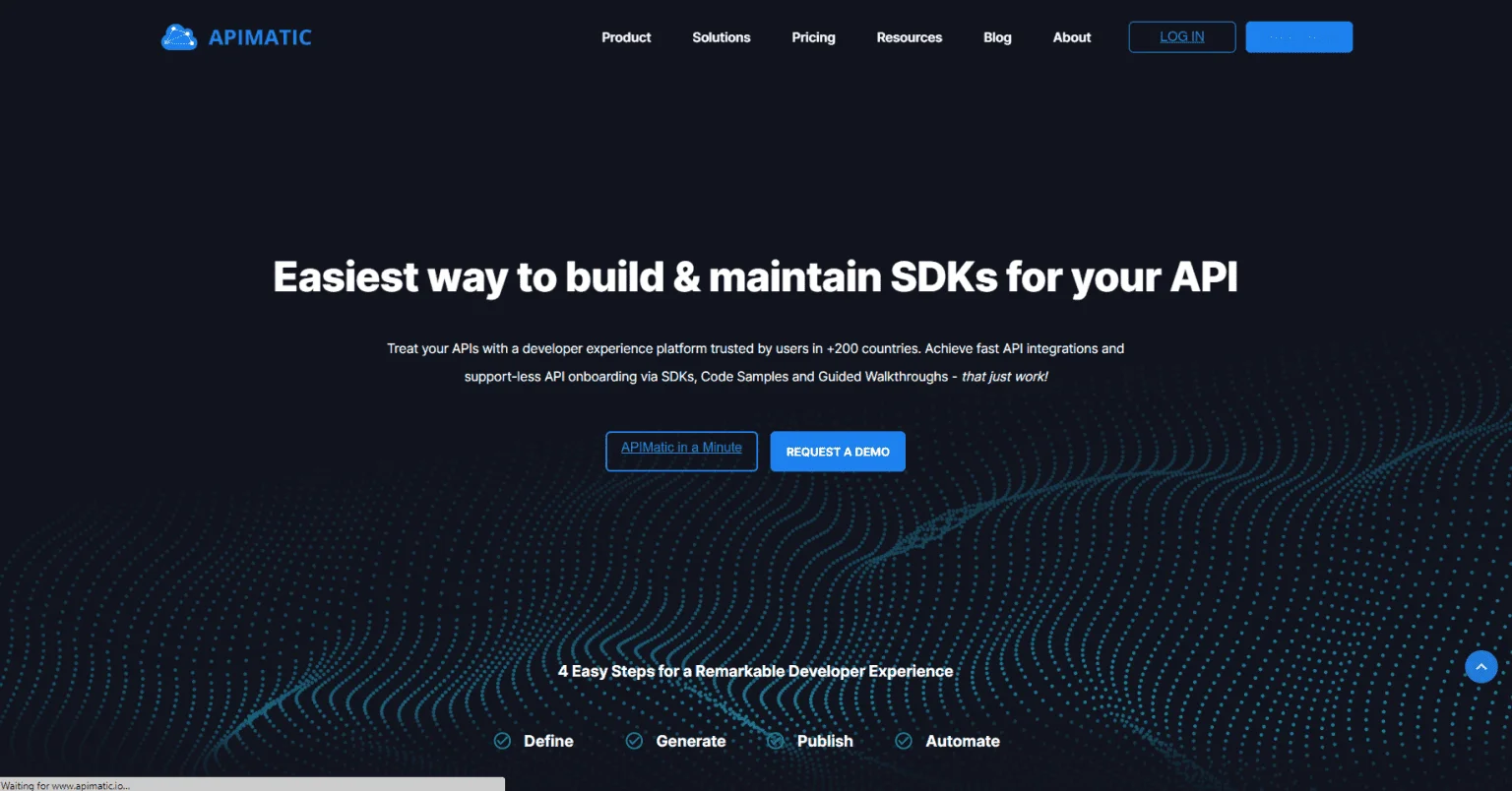
APIMatic is a platform that supports website APIs. On ten different platforms, developers utilize it to create SDKs for their APIs. Furthermore, it’s utilized to keep it up-to-date with API upgrades.
They provide cutting-edge automatic generating tools to create high-quality SDKs and code snippets from API-specific forms and convert them into other standard formations, such as RAML, API Blueprint, Postman Collections, etc.
-
Sandbox
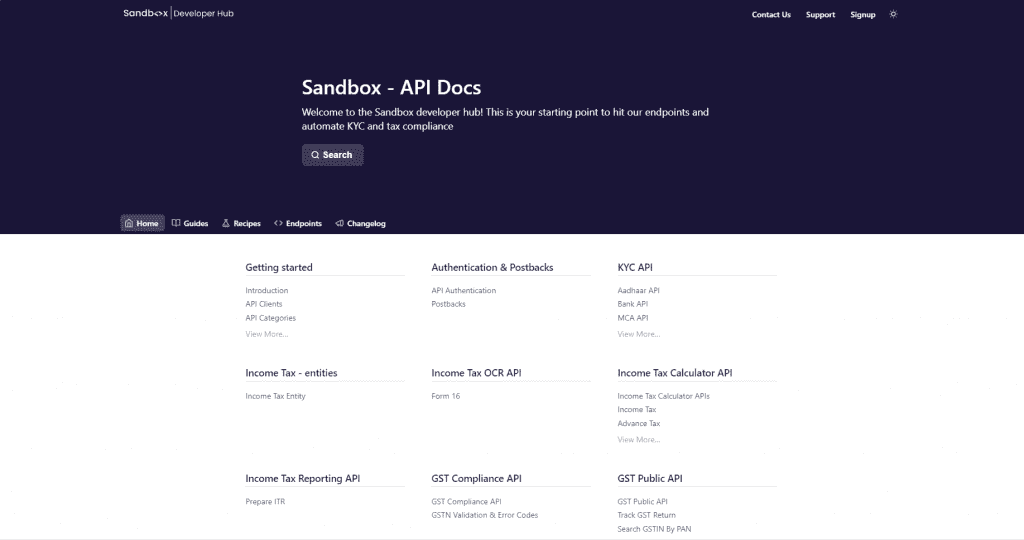
A sandbox API is a testing environment that replicates the functionality of a production API but is isolated from real data and transactions. Developers use sandbox APIs to experiment, test, and ensure their applications work correctly without affecting live systems or data.
A quick and simple mock RESTful API is provided by Sandbox using API definitions. Additionally, it lessens the danger and expense of calling third-party APIs during testing.
-
Rapid API

RapidAPI is an API marketplace and management platform that allows web developers to discover, test, and connect to thousands of APIs. It simplifies the process of finding and integrating third-party APIs.
Boost Efficiency with Low Code API Development Solutions.
Why API Development Matters?
API (Application Programming Interface) development offers numerous benefits for Custom web application developers, businesses, and end-users. Here are some of the key advantages of leveraging this tactic and approaching an API development company:
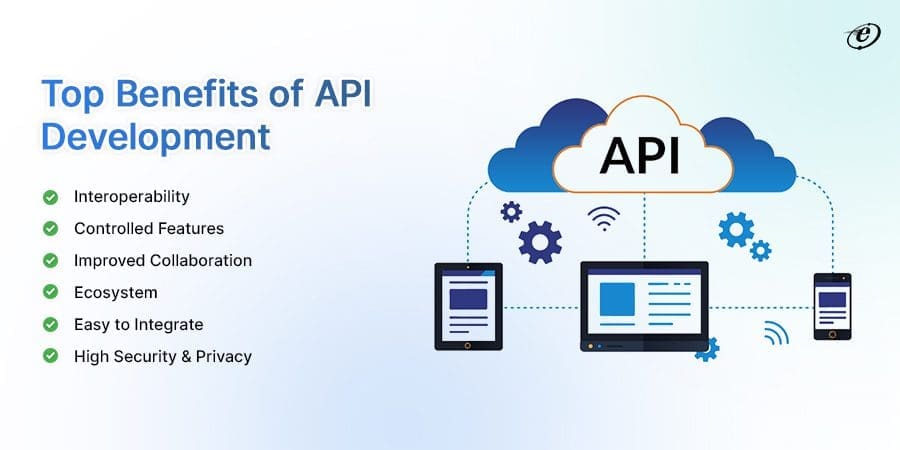
-
Interoperability
This is one of the most significant benefits, as APIs enable different software systems and applications to communicate and work together seamlessly. This promotes interoperability and allows for the integration of diverse technologies and platforms.
Now, even you can join the ranks of prominent Fortune 500 companies. Choose our outsourcing services and build a fruitful partnership.
-
Controlled Features
It is frequently noticed that the effectiveness of business software varies depending on its level. Employees sometimes find it challenging to use one or two software features necessary for their everyday tasks. APIs allow applications to scale by adding or removing features and functionalities as needed. This is especially important for businesses experiencing growth or changing requirements.
-
Improved Collaboration
Well-designed APIs can improve the user experience by enabling seamless integration with other applications and services, creating a more comprehensive and user-friendly environment. Businesses may streamline procedures and enhance teamwork through this integration. Without APIs, many businesses wouldn’t be connected, leading to information silos that would harm productivity and performance.
-
Ecosystem
By providing APIs, businesses can encourage third-party developers (outsourcing vendors) to create applications or extensions that work with their platform, thereby expanding their ecosystem and potentially increasing revenue. APIs may offer unique vendor management solutions. Only these APIs can effectively handle all tinier updates and modifications. Consequently, it successfully lowers the high costs associated with purchasing new software.
-
Easy to Integrate
In today’s fiercely competitive and technologically dependent world, businesses can only succeed with software. Regarding quickly connecting with other systems, APIs are the best choice. Therefore, beginning with integrations, swift operations, and focused data analysis all add up to businesses being able to make decisions quickly.
-
High Security & Privacy
APIs provide additional levels of protection between the infrastructure of the responding service and the requesting application during communication. Just as APIs add an additional layer of security within a network, they may do the same for individual users. The user can choose whether to permit or refuse a website’s request for their location, which is delivered via a location API.
Must-Have Features in API Development

Effective API design is an ongoing process that requires collaboration between developers and a keen understanding of the specific needs of the API’s users. You must include the below-given features in your API design to create robust, user-friendly APIs.
| Features | Description |
 Pagination |
For endpoints that return large datasets, implement pagination allows clients to request data in manageable chunks, improving performance and reducing data transfer costs. |
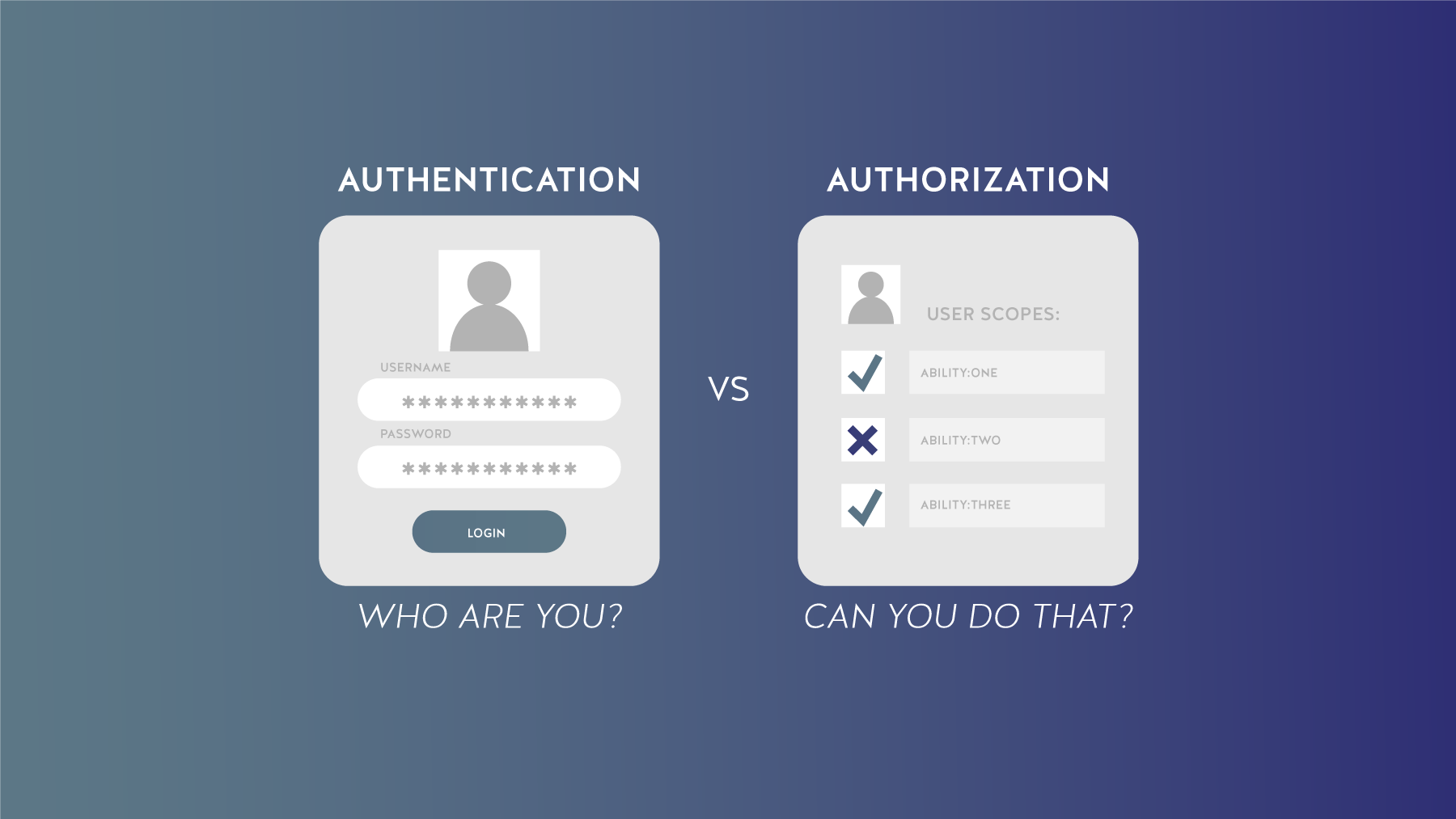 Authorization & Authentication |
Implement secure authentication and authorization mechanisms, such as OAuth, OAuth2, and JWT, to control access to your API and protect sensitive data. |
 Error Handling |
Effective error handling makes it simple to identify whether a client error or a server malfunction caused the problem. Provide clear and meaningful error messages and status codes. Help developers troubleshoot and debug issues by offering informative error responses. |
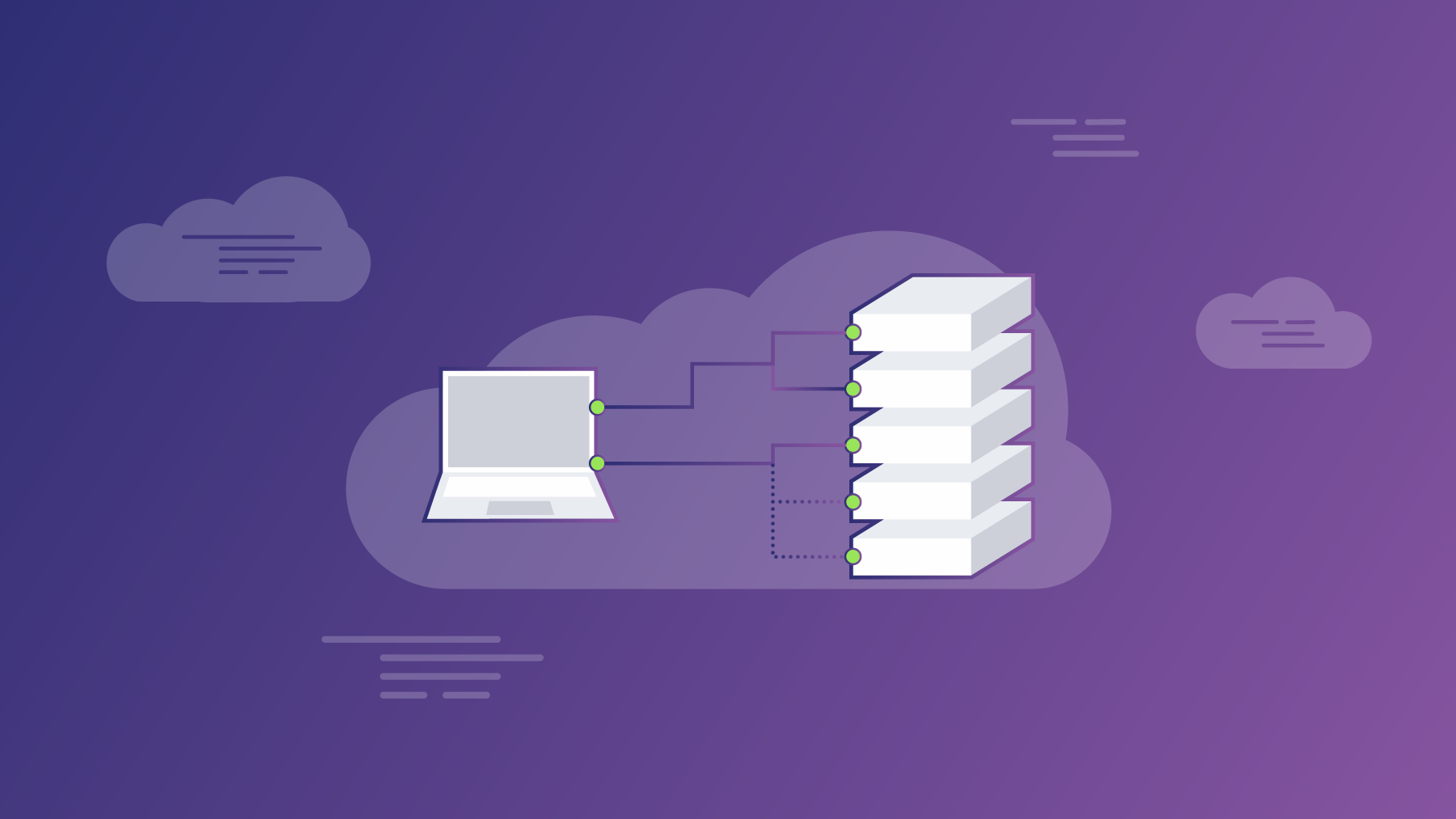 Caching |
Implement caching mechanisms to reduce the load on your server and improve response times, particularly for read-heavy APIs. By creating a cache mechanism, you can swiftly retrieve resources. Utilizing tools like Redis and Memcached, you may build a caching strategy. |
 Validation |
The verification of data accuracy is referred to as validation in APIs. While server-side validation entails tedious chores like determining what type of property it is (account number, email, etc.), client-side validation provides fast feedback. |
Wrapper |
An API wrapper is a software component that simplifies interactions with a complex external API by providing a more user-friendly and abstract interface. They consolidate several groups of API requests into simple functions. Additionally, the wrapper makes multiple API calls without contacting the user. |
What are the Best Practices for Effective API Development?
Best practices for developing APIs are essential to ensuring the creation of robust and user-friendly APIs. Here are some key guidelines:
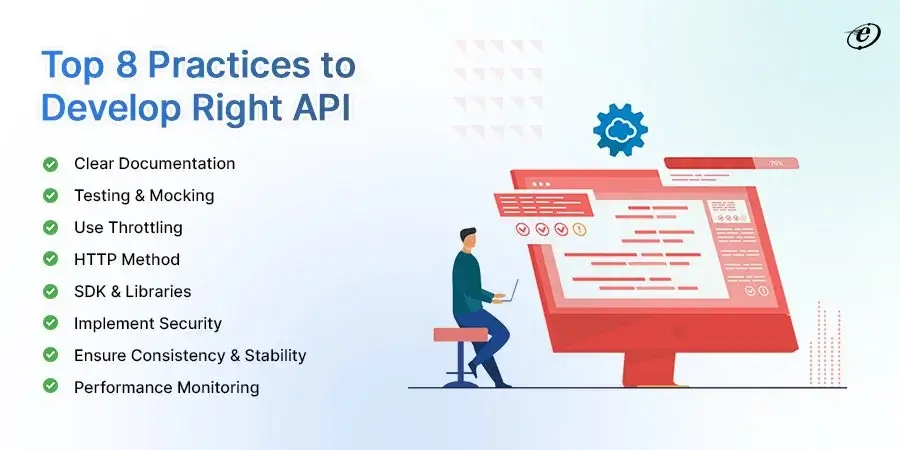
-
Clear Documentation
Detailed documentation results in an effective development process, speeding up API technology development and reducing project costs and implementation time. Therefore, provide comprehensive and up-to-date documentation, including examples and usage scenarios.
Your API documentation has to be correctly compiled. The documentation should be robust enough to guide new users through your API design easily. Also, you should ensure proper information on the use of API development languages for your project.
-
Testing & Mocking
In API development, testing and mocking are essential to ensure the reliability and efficiency of the API. Testing verifies that the API functions correctly and consistently, reducing the risk of errors and failures in production.
Mocking allows dedicated front-end developers to simulate API responses during testing, enabling them to isolate and troubleshoot components, test edge cases, and avoid unnecessary dependencies, thereby enhancing the overall quality and resilience of the API.
-
Use Throttling
App throttling is the best practice that you should consider when it comes to diverting overloaded traffic, protecting against DoS (Denial of Service), and backing up APIs. Throttling safeguards against overloading the server conserves resources, and offers a balanced experience for all users, making it an essential component of API governance.
-
HTTP Method
HTTP methods, like GET, POST, PUT, and DELETE, are fundamental in API because they determine the action to be performed on resources. Each method conveys specific intent and functionality. Due to the fact that some proxies only support POST and GET, you must permit your RESTful API to override the HTTP method. Utilizing the unique HTTP Header X-HTTP-Method-Override will enable you to achieve this.
-
SDK & Libraries
SDKs (Software Development Kits) and libraries are essential in API development because they provide pre-built code components, simplify integration, reduce development time, and ensure consistent and efficient use of the API. Therefore, you must offer essential resources to the development team to boost the speed of service development and implementation.
-
Implement Security
Implementing security measures is vital to safeguard data, protect against unauthorized access, and ensure the integrity of information. Security measures also help in compliance with legal and regulatory requirements, making it an essential aspect of API development.
You must maintain your API security while making it simple to use as an API provider. For that, one of the preferred methods of authentication is token-based authentication.
-
Ensure Consistency & Stability
Consistency and stability are crucial in API development to provide a dependable and predictable user experience. Consistent naming, design, and functionality make the API more accessible and understandable. Stability ensures that the API behaves reliably, reducing errors and disruptions for developers and applications that rely on it.
Hence, you should try to design intuitively consistent APIs. Throughout, utilize the same naming patterns.
-
Performance Monitoring
Performance monitoring allows developers to identify bottlenecks, troubleshoot issues, and optimize resource usage, ultimately providing end-users with a seamless and responsive experience. Use tools and monitoring systems to keep track of API performance, errors, and usage. This helps in identifying and addressing bottlenecks and issues.
Find the best practices to optimize performance in .NET application.
How to Build an API?
Too frequently, teams will simply consider building steps while developing API because the majority of the code was developed during that time. But that ignores the crucial design stage. Long-term API development involves a lot more than just writing code. Let’s cover all the steps to develop a robust API.

1. Define Objective
Before you start developing your API, it’s essential to have a clear understanding of its objectives and use cases.
Ask yourself:
-
-
- What data or functionality does the API need to expose?
- Who are the intended users, and what are their needs?
- How will the API be used in real-world scenarios?
-
By having a well-defined purpose for your API, you’ll be better equipped to design and develop it effectively.
2. Design & Develop API
Once you have a clear objective, it’s time to plan your API. This involves designing the API structure, endpoints, request-response formats, and authentication methods.
Some key considerations include:
-
-
- The API’s architecture: Decide whether you’ll use REST, GraphQL, or another architecture.
- Endpoints: Determine the endpoints that the API will expose, representing specific functionalities or resources.
- Data format: Choose a standardized data format, such as JSON or XML, for structuring data in API requests and responses.
- Authentication: Select a secure authentication method, such as API keys, OAuth, or JWT, to control access to the API.
-
3. Testing
Thoroughly test your API to ensure it functions as intended.
This includes:
-
-
- Unit testing: Test individual functions and components of the API.
- Integration testing: Test how different parts of the API work together.
- Security testing: Check for vulnerabilities such as SQL injection, cross-site scripting, and authentication issues.
- Load testing: Simulate heavy traffic to assess the API’s performance.
-
4. Documentation Portal
Provide a user-friendly documentation portal to make it easy for the development team to understand and use your API. The portal should be an accessible resource for users to find information, examples, and guides.
5. Feedback Loop
Establish a feedback mechanism for developers to report issues, suggest improvements, and request new features. Feedback from users is invaluable for the ongoing improvement of your API.
6. Maintenance
Regularly update and maintain your API to address issues, apply security patches, and add enhancements. Be responsive to user feedback and changing requirements.
Note* API development is an iterative process. As you gain experience and receive user feedback, you can continuously improve your API to remain secure, reliable, and up to date with evolving requirements and technologies.
Need curated assistance on the type of API that can suit your business needs? Connect with our API Development Experts Now!
How Much Does API Development Cost?
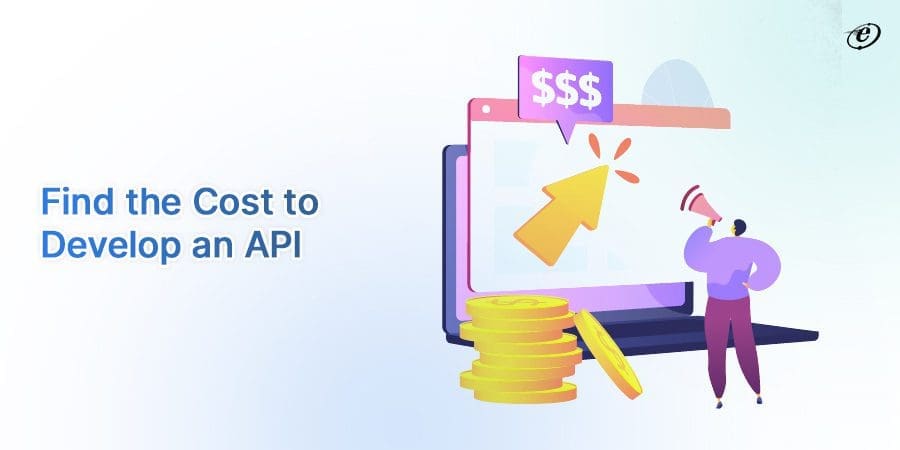
The cost of API development can vary significantly based on several factors, including the complexity of the API, the functionality it provides, the technology stack, the development team’s location and experience, and other project-specific considerations.
Although the average cost of developing an API varies in the range of $ 15,000 to $25,000, but it’s advisable to consult with an experienced API software development company to get accurate estimates based on your specific requirements. Remember that API development is an investment, and the cost should be weighed against the potential benefits and revenue generation the API can provide. For the best decision, ask for API development examples from your potential shortlisted vendors.
End Note
In today’s digital landscape, staying competitive and adaptable requires businesses to leverage the power of APIs to create interconnected ecosystems that drive growth, efficiency, and customer satisfaction.
API development is crucial for every business, enabling seamless integration of systems, applications, and services. It empowers businesses to expand their digital reach, streamline operations, and deliver superior customer experiences.
APIs now have more significance than they had in the past, not just from the standpoint of software development but also from the perspective of business collaboration. APIs have been proven to boost business profits through the appropriate technological link.
Do you want to know what kind of API your business requires? Connect with our expert API development team to clear up all your doubts!




